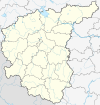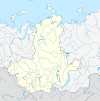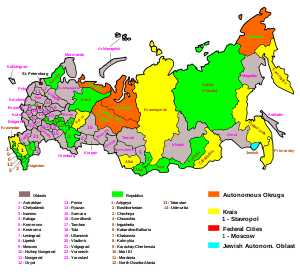Russia is divided into several types and levels of subdivisions.
Federal districts
Main article: Federal districts of Russia
The federal districts are groupings of the federal subjects of Russia. Federal districts are not mentioned in the nation's constitution, do not have competences of their own, and do not manage regional affairs. They exist solely to monitor consistency between the federal and regional bodies of law, and ensure governmental control over the civil service, judiciary, and federal agencies operating in the regions. The federal district system was established on 13 May 2000. There are total eight federal districts.
| Federal district | Date established |
Area (km) |
2021 census | HDI (2021) | GRDP (2022) | Federal subjects |
Administrative centre |
Map | |||
|---|---|---|---|---|---|---|---|---|---|---|---|
| Population | per km | Total | Per capita | ||||||||
| North Caucasian | 19 January 2010 | 170,400 | 10,171,000 | 60 | 0.793 | ₽3.111 trillion ($45 billion) |
₽305,334 ($4458) |
7 | Pyatigorsk | 
| |
| Southern | 13 May 2000 | 427,800 | 16,746,000 | 39 | 0.799 | ₽9.816 trillion ($143 billion) |
₽588,461 ($8593) |
8 | Rostov-on-Don | 
| |
| Central | 13 May 2000 | 650,200 | 40,342,000 | 62 | 0.845 | ₽47.368 trillion ($692 billion) |
₽1,176,273 ($17176) |
18 | Moscow | 
| |
| Northwestern | 13 May 2000 | 1,687,000 | 13,917,000 | 8 | 0.833 | ₽18.929 trillion ($276 billion) |
₽1,362,907 ($19901) |
11 | Saint Petersburg | 
| |
| Volga | 13 May 2000 | 1,037,000 | 28,943,000 | 28 | 0.804 | ₽19.664 trillion ($287 billion) |
₽683,355 ($9978) |
14 | Nizhny Novgorod | 
| |
| Ural | 13 May 2000 | 1,818,500 | 12,301,000 | 7 | 0.839 | ₽20.073 trillion ($293 billion) |
₽1,635,678 ($23884) |
6 | Yekaterinburg | 
| |
| Siberian | 13 May 2000 | 4,361,800 | 16,793,000 | 4 | 0.794 | ₽13.054 trillion ($191 billion) |
₽781,580 ($11412) |
10 | Novosibirsk | 
| |
| Far Eastern | 13 May 2000 | 6,952,600 | 7,976,000 | 1 | 0.808 | ₽8.656 trillion ($126 billion) |
₽1,090,778 ($15927) |
11 | Vladivostok | 
| |
Federal subjects
Main article: Federal subjects of Russia
Since 30 September 2022, the Russian Federation has consisted of eighty-nine federal subjects that are constituent members of the Federation. However, six of these federal subjects—the Republic of Crimea, the Donetsk People's Republic, the Kherson Oblast, the Lugansk People's Republic, the federal city of Sevastopol, and the Zaporozhye Oblast—are internationally recognized as part of Ukraine. All federal subjects are of equal federal rights in the sense that they have equal representation—two delegates each—in the Federation Council (upper house of the Federal Assembly). They do, however, differ in the degree of autonomy they enjoy.
De jure, excluding the occupied Ukrainian territories, there are 6 types of federal subjects—21 republics, 9 krais, 46 oblasts, 2 federal cities, 1 autonomous oblast, and 4 autonomous okrugs.
Autonomous okrugs are the only ones that have a unusual status of being federal subjects in their own right, yet at the same time they are considered to be administrative divisions of other federal subjects (with the Chukotka Autonomous Okrug being the only exception).
Status of the Ukrainian territories occupied by Russia
On 18 March 2014, as a part of the annexation of Crimea and following the establishment of the Republic of Crimea (an independent entity that was recognized only by Russia), a treaty was signed between Russia and the Republic of Crimea incorporating the Republic of Crimea and the City of Sevastopol as constituent members of the Russian Federation. According to the Treaty, the Republic of Crimea is accepted as a federal subject with the status of a republic while the City of Sevastopol has received federal city status. Neither the Republic of Crimea nor the city of Sevastopol are politically recognized as parts of Russia by most countries.
Similarly, Russia also annexed four Ukrainian oblasts of Donetsk, Kherson, Luhansk, and Zaporozhzhia on 30 September 2022 after internationally-unrecognized referendums held days prior, during the invasion of Ukraine that began in late February, which were organized by Russian occupation authorities in territories where hostilities were ongoing and much of the population had fled. It occurred seven months after the start of the invasion and less than a month after the start of the Ukrainian Kharkiv counteroffensive. The signing ceremony was held in the Grand Kremlin Palace in Moscow in the presence of occupation authority heads Leonid Pasechnik, Denis Pushilin, Yevgeny Balitsky, and Vladimir Saldo, and Russian President Vladimir Putin. Like Crimea, none of the four occupied regions are internationally recognized as part of Russia.
List
Administrative divisions
Prior to the adoption of the 1993 Constitution of Russia, the administrative-territorial structure of Russia was regulated by the Decree of the Presidium of the Supreme Soviet of the RSFSR of 17 August 1982 "On the Procedures of Dealing with the Matters of the Administrative-Territorial Structure of the RSFSR". The 1993 Constitution, however, did not identify the matters of the administrative-territorial divisions as the responsibility of the federal government nor as the joint responsibility of the federal government and the subjects. This was interpreted by the governments of the federal subjects as a sign that the matters of the administrative-territorial divisions became solely the responsibility of the federal subjects. As a result, the modern administrative-territorial structures of the federal subjects vary significantly from one federal subject to another. While the implementation details may be considerably different, in general, however, the following types of high-level administrative divisions are recognized:
- administrative districts (raions)
- cities/towns and urban-type settlements of federal subject significance
- closed administrative-territorial formations
Autonomous okrugs and okrugs are intermediary units of administrative divisions, which include some of the federal subject's districts and cities/towns/urban-type settlements of federal subject significance.
- Autonomous okrugs, while being under the jurisdiction of another federal subject, are still constitutionally recognized as federal subjects on their own right. Chukotka Autonomous Okrug is an exception in that it is not administratively subordinated to any other federal subject of Russia.
- Okrugs are usually former autonomous okrugs that lost their federal subject status due to a merger with another federal subject.
Typical lower-level administrative divisions include:
- selsoviets (rural councils)
- towns and urban-type settlements of the administrative district significance
- city districts
Municipal divisions
Main articles: Municipalities of Russia and Districts of RussiaIn the course of the Russian municipal reform of 2004–2005, all federal subjects of Russia were to streamline the structures of local self-government, which is guaranteed by the Constitution of Russia. The reform mandated that each federal subject was to have a unified structure of municipal government bodies by 1 January 2005, and a law enforcing the reform provisions went into effect on 1 January 2006. According to the law, the units of the municipal division (called "municipal formations") are as follows:
- Municipal district, a group of urban and rural settlements, often along with the inter-settlement territories. In practice, municipal districts are usually formed within the boundaries of existing administrative districts (raions).
- Urban settlement (Russia), a city/town or an urban-type settlement, possibly together with adjacent rural and/or urban localities
- Rural settlement (Russia), one or several rural localities
- Urban okrug, an urban settlement not incorporated into a municipal district. In practice, urban okrugs are usually formed within the boundaries of existing cities of federal subject significance.
- Intra-urban territory (intra-urban municipal formation) of a federal city, a part of a federal city's territory. In Moscow, these are called municipal formations (which correspond to districts); in St. Petersburg—municipal okrugs, towns, and settlements. In Sevastopol (located on the Crimean Peninsula, which is a territory disputed between Russia and Ukraine), they are known as municipal okrugs and a town.
Territories not included as a part of municipal formations are known as inter-settlement territories [ru], a concept introduced in 2019.
The Federal Law was amended on 27 May 2014 to include new types of municipal divisions:
- Urban okrug with intra-urban divisions, an urban okrug divided into intra-urban districts at the lower level of the municipal hierarchy
- Intra-urban district, a municipal formation within an urban okrug with intra-urban divisions. This municipal formation type would typically be established within the borders of existing city districts (i.e., the administrative divisions in some of the cities of federal subject significance).
In June 2014, Chelyabinsky Urban Okrug became the first urban okrug to implement intra-urban divisions.
Federal legislation introduced on May 1, 2019, added an additional territorial unit:
- Municipal okrug, a grouping of several settlements without municipal status. Municipal okrugs formally exercise local self-government either through direct means or through electoral and other institutions.
Economic regions
Main article: Economic regions of Russia
For economic and statistical purposes the federal subjects are grouped into twelve economic regions. Economic regions and their parts sharing common economic trends are in turn grouped into economic zones and macrozones.
| Economic region | Population (2021) | Area (km2) | GDP (million US$) |
|---|---|---|---|
| Central | 33,276,581 | 482,300 | 611,550 |
| Central Black Earth | 7,057,951 | 167,900 | 62,098 |
| East Siberian | 6,096,127 | 3,371,800 | 73,250 |
| Far Eastern | 7,975,762 | 6,952,600 | 100,286 |
| Kaliningrad | 1,029,966 | 15,100 | 10,600 |
| North Caucasus | 22,642,000 | 381,600 | 145,110 |
| Northern | 4,101,852 | 1,476,600 | 69,754 |
| Northwestern | 8,785,379 | 195,200 | 192,610 |
| Ural | 18,416,392 | 823,300 | 154,034 |
| Volga | 15,811,458 | 539,800 | 128,221 |
| Volga-Vyatka | 6,968,440 | 264,800 | 44,635 |
| West Siberian | 16,281,060 | 2,454,000 | 234,600 |
Military districts
Main article: Military districts of RussiaIn order for the Armed Forces to provide an efficient management of military units, their training, and other operational activities, the federal subjects are grouped into five military districts. Each military district operates under the command of the district headquarters, headed by the district commander, and is subordinated to the General Staff of the Armed Forces of the Russian Federation.

Leningrad Military District Eastern Military District Central Military District Southern Military District Moscow Military District
See also
- History of the administrative division of Russia
- List of federal subjects of Russia by area
- List of federal subjects of Russia by population
- Types of inhabited localities in Russia
- Republics of the Soviet Union
- Constituencies of Russia
Notes
- Includes the Republic of Crimea and Sevastopol, annexed by Russia in 2014, as well as Donetsk, Kherson, Luhansk, and Zaporizhia oblasts annexed in 2022; recognized as parts of Ukraine by most of the international community.
- Population figures from the Crimean Census in 2014. Crimea was annexed by Russia in 2014, after the 2010 Russian Census.
References
- Russell, Martin (October 2015). "Russia's constitutional structure" (PDF). European Parliamentary Research Service. European Parliament. doi:10.2861/664907. ISBN 978-92-823-8022-2. Retrieved November 3, 2021.
- "Russia: Federal Districts and Major Cities". City Population. Retrieved April 18, 2019.
- "Sub-national HDI – Area Database – Global Data Lab". hdi.globaldatalab.org. Retrieved July 20, 2021.
- ^ "1.1. ОСНОВНЫЕ СОЦИАЛЬНО-ЭКОНОМИЧЕСКИЕ ПОКАЗАТЕЛИ в 2014 г." [Main Socioeconomic Indicators 2014]. Regions of Russia. Socioeconomic indicators – 2015 (in Russian). Russian Federal State Statistics Service. Retrieved July 26, 2016. Cite error: The named reference "area" was defined multiple times with different content (see the help page).
- "Subnational Human Development Index (SD-201) (Russian Federation)". Global Data Lab. Radboud University Nijmegen. Retrieved April 18, 2019.
- Валовой региональный продукт по субъектам Российской Федерации в 2016–2022 гг., rosstat.gov.ru
- "Results of Census: Population of Crimea is 2.284 Million People". Archived from the original on November 4, 2015. Retrieved February 13, 2016.
- Constitution, Article 65
- ^ Kremlin.ru. "Договор между Российской Федерацией и Республикой Крым о принятии в Российскую Федерацию Республики Крым и образовании в составе Российской Федерации новых субъектов" ("Treaty Between the Russian Federation and the Republic of Crimea on Ascension to the Russian Federation of the Republic of Crimea and on Establishment of New Subjects Within the Russian Federation") (in Russian)
- "Putin signs Crimea treaty, will not seize other Ukraine regions", Reuters, 18 March 2014.
- Walker, Shaun (September 23, 2022). "'Referendums' on joining Russia under way in occupied Ukraine". the Guardian. Archived from the original on September 30, 2022. Retrieved September 24, 2022.
So-called "referendums" are under way in areas of Ukraine occupied by Russian troops, with residents told to vote on proposals for the four Ukrainian regions to declare independence and then join Russia.
- Trevelyan, Mark (September 30, 2022). "Putin declares annexation of Ukrainian lands in Kremlin ceremony". Reuters. Archived from the original on September 30, 2022. Retrieved September 30, 2022.
- "Оценка численности постоянного населения по субъектам Российской Федерации". Federal State Statistics Service. Retrieved September 1, 2022.
- ^ "Crimea becomes part of vast Southern federal district of Russia". Retrieved July 29, 2016.
- ^ "В России создан Крымский федеральный округ". RBC. March 21, 2014. Archived from the original on March 22, 2014. Retrieved November 18, 2015.
- ^ Number of Present Population of Ukraine, as of January 1 "Чисельність наявного населення України на 1 січня 2021" (PDF) (in Ukrainian and English). Kyiv: State Statistics Service of Ukraine. Archived from the original (PDF) on December 21, 2021.
- ^ "Энциклопедический словарь конституционного права". Статья "Административно-территориальное устройство". Сост. А. А. Избранов. — Мн.: Изд. В.М. Суров, 2001.
- Государственная Дума Российской Федерации. Федеральный Закон №131-ФЗ от 6 октября 2003 г. «Об общих принципах организации местного самоуправления в Российской Федерации», в ред. Федерального Закона №243-ФЗ от 28 сентября 2010 г. (State Duma of the Russian Federation. Federal Law #131-FZ of 6 October 2003 On the General Principles of Organization of the Local Self-Government in the Russian Federation, as amended by the Federal Law #243-FZ of 28 September 2010. ).
- Law #17-ZS
- The concept of inter-settlement territory in the Russian Federation
- Федеральный Закон №136-ФЗ от 27 мая 2014 г. «О внесении изменений в статью 26.3 Федерального Закона "Об общих принципах организации законодательных (представительных) и исполнительных органов государственной власти субъектов Российской Федерации" и Федеральный Закон "Об общих принципах организации местного самоуправления в Российской Федерации"». Вступил в силу со дня официального опубликования. Опубликован: Официальный интернет-портал правовой информации http://www.pravo.gov.ru, 27 мая 2014 г. (Federal Law #136-FZ of 27 May 2014 On Amending Article 26.3 of the Federal Law "On the General Principles of Organization of Legislative (Representative) and Executive Bodies of State Power in the Subjects of the Russian Federation" and the Federal Law "On the General Principles of Organization of the Local Self-Government in the Russian Federation". Effective as of the day of the official publication.).
- Законодательное Собрание Челябинской области. Закон №706-ЗО от 10 июня 2014 г. «О статусе и границах Челябинского городского округа и внутригородских районов в его составе». Вступил в силу со дня официального опубликования. Опубликован: "Южноуральская панорама", №87 (спецвыпуск №24), 14 июня 2014 г. (Legislative Assembly of Chelyabinsk Oblast. Law #706-ZO of 10 June 2014 On the Status and Borders of Chelyabinsky Urban Okrug and the City Districts It Comprises. Effective as of the day of the official publication.).
- Государственная Дума Российской Федерации. Федеральный Закон №87-ФЗ от 1 мая 2019 г. «О внесении изменений в Федеральный закон "Об общих принципах организации местного самоуправления в Российской Федерации"». (State Duma of the Russian Federation. Federal Law #87-FZ of May 1, 2019 On Changes to the Federal Law "On General Principles of the Organization of Local Self-Government in the Russian Federation". ).
- "Общероссийский классификатор экономических регионов" (ОК 024-95) введённый 1 января 1997 г., в ред. Изменения № 05/2001. Секция II. Экономические районы (Russian Classification of Economic Regions (OK 024-95) of January 1, 1997 as amended by the Amendments #1/1998 through #5/2001. Section II. Economic Regions)
- "Валовой региональный продукт по субъектам Российской Федерации в 2016-2022гг". www.rosstat.gov.ru. Archived from the original on March 31, 2023. Retrieved August 21, 2023.
- Президент Российской Федерации. Указ №900 от 27 июль 1998 г. «О военно-административном делении Российской Федерации», в ред. Указа №1144 от 20 сентябрь 2010 г. Вступил в силу 27 июль 1998 г.. (President of the Russian Federation. Decree #900 of July 27, 1998 On Military Administrative Division of the Russian Federation, as amended by the Decree #1144 of September 20, 2010. Effective as of July 27, 1998.).
Sources
- 12 декабря 1993 г. «Конституция Российской Федерации», в ред. Федерального конституционного закона №7-ФКЗ от 30 декабря 2008 г. Вступил в силу со дня официального опубликования. Опубликован: "Российская газета", №237, 25 декабря 1993 г. (December 12, 1993 Constitution of the Russian Federation, as amended by the Federal Constitutional Law #7-FKZ of December 30, 2008. Effective as of the official publication date.).
- Законодательное Собрание города Севастополя. Закон №17-ЗС от 3 июня 2014 г. «Об установлении границ и статусе муниципальных образований в городе Севастополе». Вступил в силу через 10 дней со дня официального опубликования. (Legislative Assembly of the City of Sevastopol. Law #17-ZS of June 3, 2014 On Establishing the Borders and the Status of the Municipal Formations in the City of Sevastopol. Effective as of the day which is 10 days after the day of the official publication.).
External links
| Types of administrative divisions of Russia | |
|---|---|
| Administrative divisions of the federal subjects of Russia | |
|---|---|
| Republics | |
| Krais | |
| Oblasts |
|
| Federal cities | |
| Autonomous oblast | |
| Autonomous okrugs | |
| Recognized as territory of Ukraine by most of the international community. | |
| Subdivisions of Europe | |
|---|---|
| Sovereign states |
|
| States with limited recognition | |
| Dependencies and other entities | |
| Subdivisions of Asia | |
|---|---|
| Sovereign states |
|
| States with limited recognition | |
| Dependencies and other territories | |
Categories:
